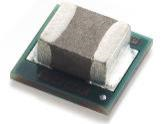SLVAE36A September 2018 – July 2021 LM43600 , LM43601 , LM46001 , LM46002 , LM5160A , LM5161 , LM5165 , LM5166 , LM61460-Q1 , LM73605 , LM73605-Q1 , LM73606-Q1 , LM76003 , LMR33620 , LMR33630 , LMR36006 , LMR36015 , LMR36500 , LMR36501 , LMR36502 , LMR36503 , LMR36506 , LMZ36002 , LMZM23600 , LMZM23601 , LMZM33602 , LMZM33603 , LMZM33606 , TPS54218 , TPS54360B , TPS54418 , TPS54424 , TPS54560B , TPS54618 , TPS55010 , TPS62148 , TPS62821 , TPS62822 , TPS62823 , TPS82130 , TPS82140 , TPS82150 , TPSM365R15 , TPSM365R3 , TPSM365R6
6 Solution Size
To keep the total DC/DC converter solution small, external components can be either integrated or optimized for the application. Non-isolated power modules have become more popular over the last few years due to the higher level of integration and ease of use, as well as the optimization of the inductor to occupy less space. The power module in Figure 6-1 is offered in 3 different current limit variations with the same pinout to provide a scalable power solution.
 Figure 6-1 TPS82130 Power Module in µSIP package
Figure 6-1 TPS82130 Power Module in µSIP package